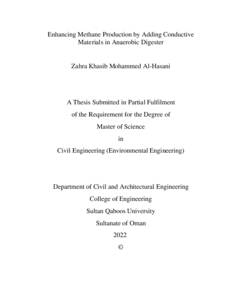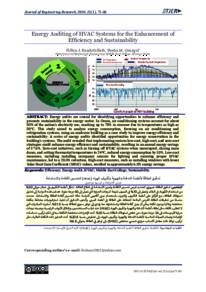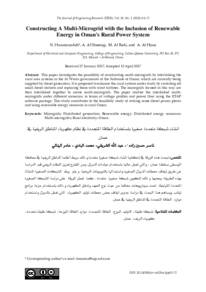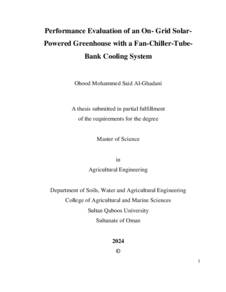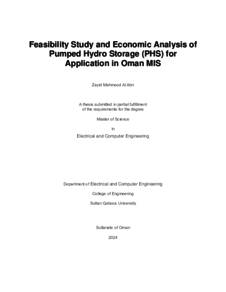Document
Enhancing methane production by adding conductive materials in anaerobic digester.
Other titles
تعزيز إنتاج الميثان عن طريق إضافة مواد موصلة في الهضم اللاهوائي
Publisher
Sultan Qaboos University.
Gregorian
2022
Language
English
English abstract
Organic waste generation and energy resource depletion have become pressing issues that
must be addressed. In this regard, adopting waste-to-energy technology is critical for
managing organic wastes and producing renewable energy. Anaerobic digestion (AD) is
among the most popular technologies that have provided dual benefits of waste treatment
and alternative energy generation. It has been commonly used to treat various types of
organic waste, such as agricultural waste, livestock manure, and wastewater sludge.
However, the low biodegradation efficiency, operating temperature, and special gas
handling requirements limit the applications of AD technology. The recent research
mainly focuses on enhancing biogas production and biodegradation efficiency. Several
studies have proved that the use of conductive additives in the AD matrix has improved
biodegradation and biogas production performance. The types of conductive additives
have a significant effect on the efficiency of AD. Therefore, this study aims to - (i)
synthesize a novel conductive composite additive from granular activated carbon (GAC)
coated with nano zero-valent iron (nZVI) by the co-precipitation method, (ii) characterize
the surface morphology and conductive behavior of the synthesized conductive materials,
and (iii) identify the effects of conductive materials addition on the efficiency of biogas
production and biodegradation in AD. Hence, thermophilic AD (TAD) was operated
under three different conditions such as (i) addition of GAC/nZVI materials in the matrix
of TAD, which was operated for co-digestion of cow manure with food wastes (ground
rice and bread); (ii) addition of GAC/nZVI materials in the matrix of TAD, which was
operated for mono-digestion of cow manure; and (iii) the control TAD without the
addition of GAC/nZVI materials in the TAD matrix, which was operated for co-digestion.
Biogas production increased by 11 folds upon using GAC/nZVI in the TAD matrix
compared with the control TAD without additives. Moreover, the addition of GAC/nZVI
increased the methane contents (%) in biogas by 20.7 folds compared with the control
TAD. This is because the addition of conductive materials in the AD matrix increased the
electron transfer between the organisms, which enhanced microbial communication and
growth. However, the addition of conductive materials in the TAD matrix did not enhance
the methane production when operated with only cow manure (mono-digestion). This is
because the cow manure possessed significantly less biodegradable nutrients for the
acetogenic and methanogenic microbes. The findings revealed that the addition of
GAC/nZVI conductive materials in the TAD matrix has a significant effect on the co digestion of cow manure blended with food wastes for methane production, COD removal,
and pH stabilization.
Member of
Resource URL
Arabic abstract
أصبح إنتاج النفايات العضوية واستنفاذ موارد الطاقة من القضايا الملحة التي يجب معالجتها. في هذا الصدد ، يعد اعتماد تكنولوجيا تحويل النفايات إلى طاقة أمًرا بالغ األهمية إلدارة النفايات العضوية وإنتاج الطاقة المتجددة. يعتبر الهضم الالهوائي )AD )من بين التقنيات األكثر شيو ًعا التي قدمت فوائد مزدوجة لمعالجة النفايات وتوليد الطاقة البديلة. لقد تم استخدام هذه التقنية بشكل شائع لمعالجة عدة أنواع من النفايات العضوية ، مثل النفايات الزراعة ، وروث الماشية ، وحمأة مياه الصرف الصحي. وبالرغم من ذلك ، فإن كفاءة التحلل البيولوجي المنخفضة ودرجة حرارة التشغيل ومتطلبات معالجة الغاز الخاصة تحد من تطبيقات تقنية AD. تركز األبحاث الحالية بشكل أساسي على تعزيز إنتاج الغاز الحيوي وكفاءة التحلل البيولوجي. حيث أثبتت العديد من الدراسات أن استخدام المواد الموصلة في مفاعل AD قد حسن التحلل البيولوجي وأداء إنتاج الغاز الحيوي. أنواع المضافات الموصلة لها تأثير كبير على كفاءة الهضم الالهوائي. لذلك ، تهدف هذه الدراسة إلى - )1( تحضير مادة موصلة مركبة جديدة من الكربون المنشط الحبيبي )GAC )مغلفة بحديد النانو صفر التكافؤ )nZVI )بطريقة الترسيب المشترك ، )2( وصف مورفولوجيا السطح والسلوك الموصل للمواد الموصلة المركبة ، و )3( تحديد تأثير إضافة المواد الموصلة على كفاءة إنتاج الغاز الحيوي والتحلل البيولوجي في AD. ومن ثم ، تم تشغيل (TAD (AD المحبة للحرارة في ظل ثالثة ظروف مختلفة مثل )1( إضافة مواد nZVI / GAC في مفاعل TAD ، والتي تم تشغيلها من أجل الهضم المشترك لروث البقر مع مخالفات الطعام )األرز المطحون والخبز( ؛ )2( إضافة مواد nZVI / GAC في مفاعل TAD ، والتي تم تشغيلها من أجل الهضم األحادي لروث البقر ؛ و )3( المفاعل المرجعي TAD بدون إضافة مواد nZVI / GAC في مفاعل TAD ، والتي تم تشغيلها من أجل الهضم المشترك. زاد إنتاج الغاز الحيوي بمقدار 11 ضعفًا عند استخدام / GAC مقارنة بالمفاعل المرجعي TAD بدون إضافات. عالوة على ذلك ، أدت إضافة / GAC ً nZVI في مفاعل TAD nZVI إلى زيادة محتوى الميثان )٪( في الغاز الحيوي بمقدار 20.7 ضعفًا مقارنة مع االمفاعل المرجعي TAD. وذلك ألن إضافة المواد الموصلة في مفاعل AD زادت من نقل اإللكترون بين الكائنات الحية ، مما عزز التواصل والنمو الميكروبيين. ومع ذلك ، فإن إضافة المواد الموصلة في مفاعل TAD لم تعزز إنتاج الميثان ، عند تشغيلها مع روث البقر فقط )الهضم األحادي(. وذلك ألن روث األبقار يحتوي على مواد مغذية أقل بشكل ملحوظ قابلة للتحلل الحيوي للميكروبات المولدة لألسيتات والميثانوجين. كشفت النتائج أن إضافة المواد الموصلة nZVI / GAC في مفاعل TAD لها تأثير كبير على الهضم المشترك لروث البقر الممزوج بمخلفات الطعام إلنتاج الميثان ، وإزالة COD ، وتثبيت الأس الهيدروجيني.
Category
Theses and Dissertations

